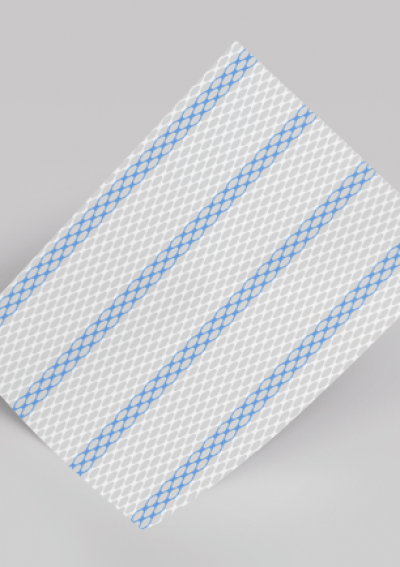Hernia Mesh
Hernia mesh is a fine net-like material used to fix hernias by keeping organs, tissue or fat from pushing through weak spots in the muscles. Many groin hernia surgeries use this mesh, but complications can arise after surgery, including pain, infections or the hernia coming back.

Hernia Mesh and Hernia Surgery
Hernia mesh is a net-like implant — often made from polypropylene plastic — that treats hernias. It prevents the tissue, organs or fat from bulging through muscle walls. Doctors commonly use mesh to treat patients with hernias because of the low hernia recurrence rate.
- According to the Food and Drug Administration, doctors in the U.S. treat more than 1 million hernias every year and use mesh in most of these cases.
- More than 20 million hernia surgeries occur worldwide yearly.
- Experts believe the complication rate for mesh is between 12% and 30%.
- Men have a lifetime risk of 27% for developing a hernia in the groin, while women have a 3% risk.
- The frequency of hernia repair increases with age, from 0.25% at age 18 to 4.2% at ages 75–80.
- Over 90% of all inguinal hernias occur in men.
While typically a safe procedure, there are possible complications, including infection, chronic pain, neuralgia (nerve pain), hernia mesh failure and hernia recurrence. These can lead to additional surgeries. Patients should discuss potential complications and surgery alternatives with their doctors.
Pros and Cons of Using Hernia Mesh
Hernia mesh can successfully repair hernias, but complications are possible. Infection, for example, is a risk. One study found that staphylococcus aureus (staph infection) was present in 64% of infected hernia mesh tested.
- Lower rate of hernia recurrence
- Mesh can repair larger weak areas
- Decreased recovery time
- Mesh can migrate, shrink or cause other complications
- Mesh may get infected, requiring removal
- Mesh failure requires one or more revision surgery
Sometimes, the risks of hernia mesh outweigh the benefits. The likelihood and severity of complications depend on the surgeon and surgical technique, mesh material and the body’s response.
Research shows that around 16% of patients require revision surgery, with non-mesh or suture-based repairs experiencing higher recurrence rates. The ideal hernia mesh resists infection and an inflammatory response while staying flexible and quickly incorporating into the body’s tissue.
How Long Does Hernia Repair Last?
Non-absorbable hernia repair mesh should be a permanent fix, but absorbable mesh typically dissolves in 12–18 months. Hernia recurrence is possible even with non-absorbable mesh.
Research suggests that mesh materials may affect recurrence rates after hernia repair. Polypropylene mesh is highly durable, but it can lead to inflammation in the area. This has a shrinking effect on the mesh, creating higher recurrence rates.
Hernia Mesh Complications
The FDA is aware of complications from recalled meshes and those currently on the market. While many people experience improved quality of life following hernia treatment, others report mild to serious complications.
- Adhesion:
- Unwanted attachment of the mesh to loops of the bowel or other tissue
- Bowel obstruction:
- Perforation of the intestines that creates a blockage
- Hernia recurrence:
- Reappearance of a hernia at the original site
- Mesh migration:
- Movement because of poor adhesions or pressure
- Mesh shrinkage:
- Shrinking mesh that pulls on tissue and causes pain
- Persistent pain:
- Discomfort or pain near the leg, groin, abdomen, stomach or testicles
- Seroma:
- Painful lump or mass of clear fluid
- Wound infection:
- Infections occurring around the site
You may experience fever, flu-like symptoms, nausea, vomiting or constipation. Other signs of hernia mesh failure include chronic pain and severe swelling or tenderness at the surgery site.
A 2024 study published in the journal Current Problems in Surgery found that 12% of patients suffer from chronic pain after having inguinal hernia mesh surgery. In contrast, only 6% of those who had the surgery without mesh experienced similar long-term pain.
A 2024 retrospective study published in Cureus found that 17.2% of hernia repair patients reported complications.
- Wound infection (5.8%)
- Seroma formation or fluid buildup (2.9%)
- Mesh infection (1.8%)
Experts also recognize obesity and diabetes as important risk factors for postoperative complications.
Hernia mesh failure can occur a few weeks to a few years after your surgery. Talk to your doctor if you notice anything wrong or unusual after your hernia surgery.
Types of Hernia Mesh
Hernia mesh materials fall into different categories: synthetic, biological, coated, composite and hybrid meshes. Mesh is available in different weaves, sizes and strengths as patches and plugs.
Mesh type may be associated with outcomes, and mesh choice could depend on hernia type.
Different mesh materials lead to varying rates of complications. In an April 2023 meta-analysis in Surgery, researchers concluded that biologic meshes increase the rate of complications on surgery site infections and hernia recurrences. As an alternative, uncoated synthetic mesh with large pores may be suitable for open ventral (abdominal) hernia repair.
Absorbable or Biologic Hernia Mesh
Biologic hernia mesh uses animal or human donor tissue — often intestines or skin of cows and pigs — with the cells removed to create a collagen net. The material breaks down over time and absorbs into the body.
A surgeon may choose this mesh for a strangulated hernia or if there is an infection in the location. Recurrence is a potential complication.
Non-Absorbable or Synthetic
A surgeon could use a woven or knitted sheet of synthetic mesh. These materials remain in the body indefinitely and include polyester, polypropylene or expanded polytetrafluoroethylene (a material made from thin, porous sheets of minerals). These types of mesh are chemically inactive and should minimize reaction complications.
While polypropylene is one of the more common mesh materials, it can wear away or break down over time. If this occurs, the mesh could protrude or cause injury to surrounding tissue.
Hybrid, Coated or Composite
These materials have non-absorbable or absorbable coatings, such as cellulose, beta-glucan, omega-3 fatty acids or collagen. The coatings minimize the body’s inflammatory response.
A leading benefit of choosing a coated or composite mesh is that surgeons can use it in the abdomen’s peritoneal cavity with little risk of adhesion (scar tissue) formation. Studies show varying degrees of inflammation risk from composite mesh, depending on the materials used.
Glue vs. Suture
Glue fixation has several advantages over the use of sutures in hernia repair. Glue reduces the occurrence of several significant side effects, including chronic pain, acute post-surgery pain and hematomas (bleeding outside of the blood vessels). In addition, patients who receive hernia surgeries with glue fixation typically return to normal activities faster than those with sutures.
Hernia Mesh Recalls and Market Withdrawals
Several manufacturers voluntarily withdrew or recalled their hernia mesh from the market. Some recalls resulted from packaging errors, higher-than-expected failure rates or the risk of serious complications such as adhesions, pain and hernia recurrence.
-
December 2020:
Ethicon, Inc. issued a recall on the Proceed surgical mesh device because a hair was found inside the packaging of a unit.
-
March 2019:
ACell, Inc. recalled its Gentrix Surgical Matrix Thick product because a sample from the lot failed to meet company tensile strength specifications.
-
November 2018:
Covidien/Medtronic recalled its Parietex Composite Parastomal Mesh after receiving reports of parastomal (abdominal wall) mesh failure.
-
August 2016:
Novus Scientific issued a recall to add to the product’s instructions and present additional information relating to clinical study results.
Manufacturers should (and usually do) voluntarily withdraw products if they violate laws administered by the FDA. A drug or device recall occurs when there is evidence that the product is harmful or defective. In some cases, if a manufacturer fails to recall a faulty product voluntarily, the FDA may issue a mandatory recall.
Hernia Mesh Brands and Manufacturers
A dozen major hernia mesh manufacturers dominate the U.S. market. Product options come in various sizes across brands.
| Manufacturer | Products Lines and Brands |
|---|---|
| Atrium | C-QUR, Vitamesh, Proloop, Prolite, Prolite Ultra |
| Autosuture | Surgipro |
| B. Braun | Safil, Premilene |
| C.R. Bard/Bard Davol | 3DMax, AlloMaxBard Soft Mesh, Bard Mesh Sheets, CollaMend, Composix, Dulex, Kugel, MK Patch, OnFlex, PerFix Plug, Phasix Mesh, Phasix, Sepramesh IP Composite, Ventralex, Ventralight, Ventrio, Visilex, XenMatrix Surgical Graft |
| Cook Medical | Biodesign (formerly Surgisis) |
| Covidien/Medtronic | Parietene, Parietex, Permacol, ProGrip, Symbotex, Versatex, Permacol, Transorb, Dextile |
| Ethicon/Johnson & Johnson | Physiomesh, Proceed, Vicryl, Securestrap, Prolene, UltraPro, UltraPro Advanced |
| FEG Textiltechnik | Dynamesh |
| Beckton Dickinson (formerly Genzyme) | Sepramesh IP Composite |
| PFM Medical (formerly GfE) | TiMESH |
| Gore Medical | Bio-A, DualMesh, Gore-Tex Soft Tissue Patch, Synecor, Mycromesh (discontinued) |
| LifeCell | Strattice |
Manufacturers that issued a recall for one or more of their hernia mesh products include Atrium Medical, Bard Davol, Ethicon/Johnson & Johnson and Covidien/Medtronic. If you have questions about which hernia mesh was used in your surgery, contact your surgeon’s office.
Hernia Mesh Lawsuits Filed Over Complications
Thousands of hernia mesh lawsuits accuse manufacturers of producing devices that cause serious complications.
Four major mesh makers are central to separate multidistrict litigations, significant court actions that combine similar lawsuits in a single federal court. In MDLs, plaintiffs receive a portion of the settlement award, often based on the severity of their case.
Active Hernia Mesh MDLs
| Atrium Medical | |
|---|---|
| Brands Named | C-QUR |
| MDL Location | New Hampshire District |
| Pending Lawsuits | 322 |
| Expected Trial Dates | In settlement |
| Ethicon | |
|---|---|
| Brands Named | Physiomesh Flexible Composite Hernia Mesh |
| MDL Location | Georgia, Northern District |
| Pending Lawsuits | 1 |
| Expected Trial Dates | In settlement |
| Bard Davol | |
|---|---|
| Brands Named | All polypropylene mesh brands |
| MDL Location | Ohio, Southern District |
| Pending Lawsuits | 23,818 |
| Next Expected Trial Date | In October 2024, Becton Dickinson, Bard Davol’s parent company, announced a settlement to resolve state and federal hernia mesh lawsuits. |
| Covidien | |
|---|---|
| Brands Named | All hernia mesh brands |
| MDL Location | Massachusetts |
| Pending Lawsuits | 2,205 |
| Expected Trial Dates | Still in discovery phase, no bellwether trial date set (expected to start in late 2025 or early 2026) |
Hernia mesh manufacturers often settle out of court with plaintiffs to avoid going to trial. For instance, in February 2023, the Attorney General for the state of Kentucky announced that Ethicon settled litigation for close to $10 million.
46 Cited Research Articles
Consumernotice.org adheres to the highest ethical standards for content production and references only credible sources of information, including government reports, interviews with experts, highly regarded nonprofit organizations, peer-reviewed journals, court records and academic organizations. You can learn more about our dedication to relevance, accuracy and transparency by reading our editorial policy.
- U.S. Food & Drug Administration. (2025, January 18). Class 2 Device Recall Proceed Surgical Mesh. Retrieved from https://www.accessdata.fda.gov/scripts/cdrh/cfdocs/cfres/res.cfm?id=184219
- Miller, R.V. (2025, January 5). Hernia Mesh Lawsuit. Retrieved from https://www.lawsuit-information-center.com/how-much-compensation-can-you-expect-for-a-hernia-mesh-lawsuit.html
- U.S. Judicial Panel on Multidistrict Litigation. (2024, November 1). MDL Statistics Report - Distribution of Pending MDL Dockets by Actions Pending. Retrieved from https://www.jpml.uscourts.gov/sites/jpml/files/Pending_MDL_Dockets_By_Actions_Pending-November-1-2024_0.pdf
- Pierson, B. (2024, October 3). Becton Dickinson Agrees to Settle About 38,000 Hernia Mesh Suits. Retrieved from https://www.reuters.com/legal/litigation/becton-dickinson-agrees-settle-about-38000-hernia-mesh-suits-2024-10-03/
- Reistrup, H. et al. (2024, April). Higher Rate of Chronic Pain in Young Men After Open Mesh vs. Nonmesh Repair of Elective Primary Unilateral Indirect Inguinal Hernia: A Nationwide Questionnaire Study. Retrieved from https://www.sciencedirect.com/science/article/pii/S0011384024000212
- Assakran, B. S. et al. (2024, January 9). Risk Factors for Postoperative Complications in Hernia Repair. Retrieved from https://www.ncbi.nlm.nih.gov/pmc/articles/PMC10777094/
- U.S. Food & Drug Administration. (2023, July 13). Surgical Mesh Used for Hernia Repair: Information for Patients. Retrieved from https://www.fda.gov/medical-devices/hernia-surgical-mesh-implants/hernia-surgical-mesh-implants-information-patients
- U.S. Food & Drug Administration. (2023, July 13). Hernia Surgical Mesh Implants. Retrieved from https://www.fda.gov/medical-devices/implants-and-prosthetics/hernia-surgical-mesh-implants
- de Figueiredo, S.M.P. et al. (2023, April). Biologic Versus Synthetic Mesh in Open Ventral Hernia Repair: A Systematic Review and Meta-Analysis of Randomized Controlled Trials. Retrieved from https://www.surgjournal.com/article/S0039-6060(22)01030-3/fulltext
- Birolini, C. et al. (2023, February 9). Microbiology of Chronic Mesh Infection. Retrieved from https://link.springer.com/article/10.1007/s10029-023-02747-6
- Baker, J.J. et al. (2023, February). Reoperation for Recurrence Is Affected by Type of Mesh in Laparoscopic Ventral Hernia Repair. Retrieved from https://journals.lww.com/annalsofsurgery/Abstract/2023/02000/Reoperation_for_Recurrence_is_Affected_by_Type_of.24.aspx
- Wang, Z. et al. (2022, November 29). Plasma-Induced Diallyldimethylammonium Chloride Antibacterial Hernia Mesh. Retrieved from https://pubs.acs.org/doi/10.1021/acsabm.2c00695
- Jangjoo, A. et al. (2022, September 2). Mesh Migration Following Abdominal Hernia Repair: A Case Report, and Literature Review. Retrieved from http://caspjim.com/article-1-2970-en.html
- Aziz, S.S. et al. (2022, July 13). Comparison of Early Outcomes in Patients Undergoing Suture Fixation Versus Tack Fixation of Mesh in Laparoscopic Transabdominal Preperitoneal (TAPP) Repair of Inguinal Hernia. Retrieved from https://www.cureus.com/articles/103296-comparison-of-early-outcomes-in-patients-undergoing-suture-fixation-versus-tack-fixation-of-mesh-in-laparoscopic-transabdominal-preperitoneal-tapp-repair-of-inguinal-hernia
- Saha, T. et al. (2022, July). A Review of Recent Developments of Polypropylene Surgical Mesh for Hernia Repair. Retrieved from https://www.sciencedirect.com/science/article/pii/S2352952022000093
- Ayuso, S.A. et al. (2022, July). Coated Polypropylene Mesh Is Associated With Increased Infection in Abdominal Wall Reconstruction. Retrieved from https://www.sciencedirect.com/science/article/abs/pii/S0022480422000464
- Layer, T. et al. (2022, May 10). Incisional Hernia Repair with a Slowly Absorbable P4HB Mesh: What Happens After the Mesh Disappears? A Retrospective Longitudinal Clinical Study. Retrieved from https://link.springer.com/article/10.1007/s10029-022-02616-8
- Smith, S.M. et al. (2022, April 21). Mesh Versus Non-Mesh Repair of Groin Hernias: A Rapid Review. Retrieved from https://onlinelibrary.wiley.com/doi/10.1111/ans.17721
- Whittaker, R. et al. (2022, March 1). Emergent and Urgent Ventral Hernia Repair: Comparing Recurrence Rates Amongst Procedures Utilizing Mesh Versus No Mesh. Retrieved from https://link.springer.com/article/10.1007/s00464-022-09101-4
- Phoa, S. (2022, February 3). Comparison of Glue Versus Suture Mesh Fixation for Primary Open Inguinal Hernia Mesh Repair by Lichtenstein Technique: A Systematic Review and Meta-Analysis. Retrieved from https://link.springer.com/article/10.1007/s10029-022-02571-4
- Wilson, R.B. et al. (2022, January 21). Risks and Prevention of Surgical Site Infection After Hernia Mesh Repair and the Predictive Utility of ACS-NSQIP. Retrieved from https://link.springer.com/article/10.1007/s11605-022-05248-6
- Rosen, M.J. et al. (2022, January 19). Biologic vs Synthetic Mesh for Single-stage Repair of Contaminated Ventral Hernias. Retrieved from https://jamanetwork.com/journals/jamasurgery/fullarticle/2788222
- Gudigopuram, S.V.R., et al. (2021, November 16). Inguinal Hernia Mesh Repair: The Factors to Consider When Deciding Between Open Versus Laparoscopic Repair. Retrieved from https://pmc.ncbi.nlm.nih.gov/articles/PMC8675396/
- Attaar, M. et al. (2021, July). Mesh in Elective Hernia Repair: 10-Year Experience with Over 6,000 Patients. Retrieved from https://journals.lww.com/journalacs/abstract/2021/07000/mesh_in_elective_hernia_repair__10_year_experience.10.aspx
- Harris, H.W. et al. (2021, April). Preventing Recurrence in Clean and Contaminated Hernias Using Biologic Versus Synthetic Mesh in Ventral Hernia Repair. Retrieved from https://journals.lww.com/annalsofsurgery/abstract/2021/04000/preventing_recurrence_in_clean_and_contaminated.7.aspx
- Madsen, L.J. et al. (2020, April 6). Mesh Versus Suture in Elective Repair of Umbilical Hernia: Systematic Review and Meta-Analysis. Retrieved from https://academic.oup.com/bjsopen/article/4/3/369/6061450
- Ssentongo, A.E. et al. (2020, February). Pain and Dysfunction with Sexual Activity after Inguinal Hernia Repair: Systematic Review and Meta-Analysis. Retrieved from https://journals.lww.com/journalacs/abstract/2020/02000/pain_and_dysfunction_with_sexual_activity_after.8.aspx
- See, C.W. et al. (2020). Hernia Mesh and Hernia Repair: A Review, Retrieved from https://www.sciencedirect.com/science/article/pii/S2666138120300025
- Gomez-Gil, V. et al. (2019, February 27). Evaluation of Synthetic Reticular Hybrid Meshes Designed for Intraperitoneal Abdominal Wall Repair: Preclinical and In Vitro Behavior. Retrieved from https://journals.plos.org/plosone/article?id=10.1371/journal.pone.0213005
- Branley, A. (2018, December 1). Hernia Mesh Concerns Grow Among Men as More Patients Report Surgery Complications. Retrieved from https://www.abc.net.au/news/2018-12-02/hernia-mesh-concerns-grow-among-men-surgery-complications/10570182
- U.S Food & Drug Administration. (2018, November 14). Class 2 Device Recall Parietex Composite Parastomal Mesh. Retrieved from https://www.accessdata.fda.gov/scripts/cdrh/cfdocs/cfRES/res.cfm?id=168668
- Wise, J. (2018, September 27). Hernia Mesh Complications May Have Affected Up to 170 000 Patients, Investigation Finds. Retrieved from https://www.bmj.com/content/362/bmj.k4104
- Zargar, N. et al. (2018, June 19). The Regulatory Ancestral Network of Surgical Meshes. Retrieved from https://journals.plos.org/plosone/article?id=10.1371/journal.pone.0197883
- Kockerling, F. et al. (2018, January 31). What Is the Evidence for the Use of Biologic or Biosynthetic Meshes in Abdominal Wall Reconstruction? Retrieved from https://link.springer.com/article/10.1007/s10029-018-1735-y
- HerniaSurge Group. (2018, January 12). International Guidelines for Groin Hernia Management. Retrieved from: https://link.springer.com/article/10.1007%2Fs10029-017-1668-x
- Elghali, M.A. et al. (2018). Unusual Complication of Seroma After Ventral Hernia Mesh Repair: Digestive Perforation by Tacks. A Case Report. Retrieved from https://www.sciencedirect.com/science/article/pii/S2210261218304681?via%3Dihub
- Kulacoglu, H. (2018). Comments on the New Groin Hernia Guidelines: What Has Changed? What Has Remained Unanswered? Retrieved from https://www.turkjsurg.com/abstract/1568/eng
- Elango, S. et al. (2017, August 25). Mesh Materials and Hernia Repair. Retrieved from https://www.ncbi.nlm.nih.gov/pmc/articles/PMC5571666/
- Baylon, K. et al. (2017, August 22). Past, Present and Future of Surgical Meshes: A Review. Retrieved from https://www.mdpi.com/2077-0375/7/3/47
- Kontogiannis, S. et al. (2016, October 18). Reasons for and Against Use of Non-absorbable, Synthetic Mesh During Pelvic Organ Prolapse Repair, According to the Prolapsed Compartment. Retrieved from https://link.springer.com/article/10.1007/s12325-016-0425-3
- Kokotovic, D. et al. (2016, October 18). Long-term Recurrence and Complications Associated with Elective Incisional Hernia Repair. Retrieved from https://jamanetwork.com/journals/jama/fullarticle/2565771
- Science Daily. (2016, October 18). Study Finds Mixed Results for Use of Mesh for Hernia Repair. Retrieved from https://www.sciencedaily.com/releases/2016/10/161018094928.htm
- Nikkolo, C. et al. (2015, December 4). Chronic Pain After Open Inguinal Hernia Repair. Postgraduate Medicine. Retrieved from https://www.tandfonline.com/doi/abs/10.1080/00325481.2016.1121090
- Narkhede, R. et al. (2015, June 27). Postoperative Mesh Infection—Still a Concern in Laparoscopic Era. Retrieved from https://link.springer.com/article/10.1007/s12262-015-1304-x
- Lockhart, K., et al. (2015). Mesh Versus Non-Mesh for Inguinal and Femoral Hernia Repair. Retrieved from https://www.cochranelibrary.com/cdsr/doi/10.1002/14651858.CD011517/epdf/full
- Sternschuss, G. et al. (2012, July 1). Post-Implantation Alterations of Polypropylene in the Human. Retrieved from https://www.auajournals.org/doi/10.1016/j.juro.2012.02.2559
Calling this number connects you with a Consumer Notice, LLC representative. We will direct you to one of our trusted legal partners for a free case review.
Consumer Notice, LLC's trusted legal partners support the organization's mission to keep people safe from dangerous drugs and medical devices. For more information, visit our partners page.
855-877-5976

